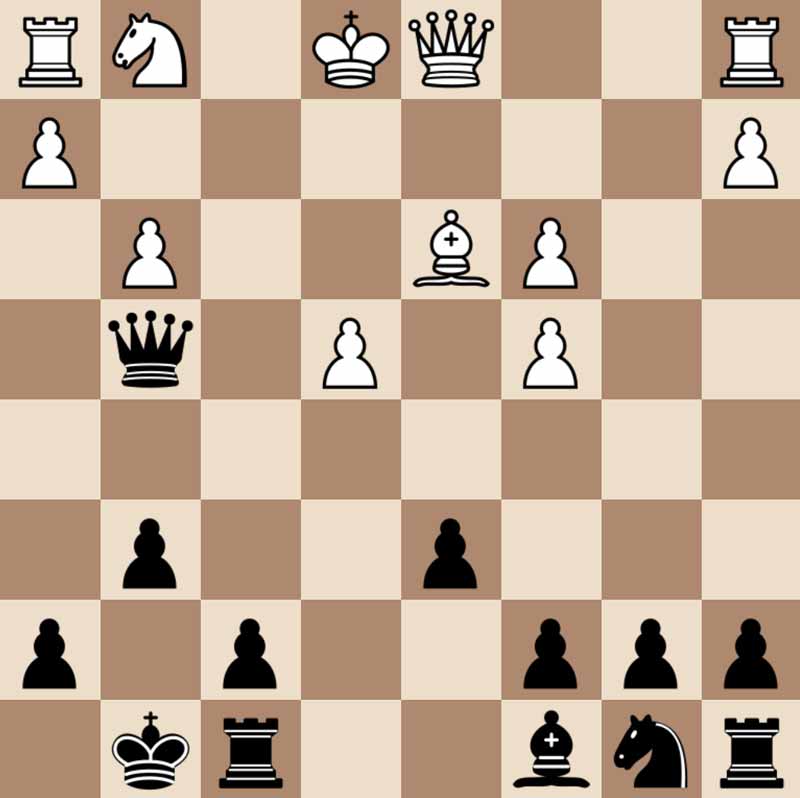The Kings Indian Defense is known for being a sharp and aggressive opening. Such openings are always a breeding ground for tactics. The KID is no different. In this article, you’ll see the typical traps and tactical ideas in this opening, for White and Black.
You will also learn what to watch out for in such situations. All of it will help you develop your tactical intuition in this opening.
Tactics for White in the KID
Tactic #1
1.d4 Nf6 2.c4 g6 3.Nc3 Bg7 4.e4 d6
And here White chooses
5.Be2
This is the Averbakh Variation of the Kings Indian Defense. In this sub variation, the play is more focussed in the centre. Black continues…
5…O-O 6.Bg5
Now the bishop eyes the h4-d8 diagonal, where Black’s queen is located.
6…e5??
This is a blunder which justifies all of White’s moves. White now obtains a winning advantage after a few forcing moves.
7.dxe5 dxe5 8.Qxd8 Rxd8 9.Nd5!
And Black has huge problems. They cannot take their knight with 9…Nxd5 as after that, they lose their rook on d8.
While if they defend the knight with 9…Nbd7, they lose a pawn after 10.Nxc7 or White can mount up the pressure with the engine move 10.Rd1! In both cases, White has a huge advantage.
Useful Tip – With Bg5, one of White’s ideas is to mount pressure on the h4-d8 diagonal. Stay alert to that.
Tactic #2
1.d4 Nf6 2.c4 g6 3.Nc3 Bg7 4.e4 d6 5.f3
This is the Samisch Variation where White’s main idea is to solidly defend their centre and continue development peacefully.
5…O-O 6.Be3 e5 7.d5 Nbd7 8.Nh3!?
The idea is to bring the Nf2, from where the knight covers any check from the h4-e1 diagonal. You’ll soon realize why this is so important.
8…Nc5 9.Nf2 Ne8 10.g4 Qh4?!
Black wants to play the typical …Bh6 and exchange the dark-squared bishop. But White is the great Karpov, a master at understanding opponent’s ideas. He stops Black’s threat while creating one of his own with…
11.Qd2! f5??
Black fails to spot White’s killer idea. White traps the Black queen now, winning the game.
12.Bg5!
The Queen has nowhere to go.
Useful Tip – If Black develops the queen early to h4, there’s a chance to trap it. Also remember the importance of Nh3-f2 maneuver.
These are common tactics that could occur in White’s game. Now let’s see two common tactical motifs from Black’s perspective.
Tactics for Black in the KID
Tactic #3
1.d4 Nf6 2.c4 g6 3.Nc3 Bg7 4.e4 d6 5.f3
Once again the Samisch Variation, but here it’s White who falls into the trap.
5… O-O 6.Be3 e5 7.Bd3?
With this move, White blocks their queen’s support to the d4-pawn. Now Black gains a huge positional and material advantage. They play
7…Ng4!
This is a very typical way of grabbing the dark squared bishop. It also occurs in the Sicilian Dragon, another opening that’s similar to the King’s Indian Defence. Here, Black sacrifices their knight, but they immediately gain the material because of a pawn fork.
8.fxg4 exd4!
The d4-pawn forks the e3-bishop and the c3-knight, regaining one of the pieces. White can’t take on d4 because Black’s fianchetto bishop supports it.
9.Bd2 dxc3
Black has regained the piece!
10.Bxc3 Bxc3+ 11.bxc3 Qh4+ 12.g3 Qxg4
Apart from being materially ahead, Black has also ruined White’s pawn structure and has a winning advantage.
Useful Tip – When the bishop is on e3 and White hasn’t pushed their pawn to d5, look for tactics with Ng4, even if the g4-square is defended. Sometimes, there might be a hidden opportunity.
Tactic #4
1.d4 Nf6 2.c4 g6 3.Nc3 Bg7 4.e4 d6 5.f3 O-O 6.Be3 e5 7.d5 a5 8.Qd2 Na6 9.Bh6?
Remember we talked about the importance of maneuvering Nh3-Nf2 to cover the e1-h4 diagonal from checks?
Recall Tactic #2. Here you’ll understand why.
9…Nxe4!
Black gains a tempo by attacking the White queen. They have also opened up the h4-square for their queen, which turns out to be crucial.
10.Nxe4 Qh4+
The queen double attacks both – the king on e1 and the bishop on h6, therefore regaining the piece on the next move.
11.g3 Qxh6 12.Nf6+
Now Black can’t take 12…Bxf6, because they’ll lose their queen after 13.Qxh6. So they simply play
12…Kh8
With a huge advantage. They have an extra pawn, White feels the absence of their dark-squared bishop whereas Black has a monster on g7.
Useful Tip – Always be alert in lines with 5.f3 Saemisch Variation. Thanks to the f-pawn push, there will be tactics when White ignores the h4-e1 diagonal with their king stuck in the centre.
Bonus : A Typical Demonstration of King’s Indian Tactics
Here you’ll see one of the most common tactical sequences for Black.
1.d4 Nf6 2.c4 g6 3.Nc3 Bg7 4.e4 d6 5.Nf3 O-O 6.Be2 e5 7.O-O Nc6 8.d5
Ne7 9.Ne1 Nd7 10.Be3 f5 11.f3 f4 12.Bf2 g5 13.Nd3 Ng6 14.c5 Nf6 15.cxd6
cxd6
This is a very common way of playing the King’s Indian Defense. Black
wants to crush White’s kingside with a huge attack. So if White goes
16.Nb5
Black continues with
16…g4 17.Nxa7 g3 18.hxg3 fxg3
The g3-pawn is a thorn in White’s camp. They can’t capture it with 19.Bxg3 as then the a7-knight hangs with 19…Rxa7. So they must play
19.Be3 Nxd5
Blowing up the centre. Black is totally crushing and some typical tactics for Black appear on the board.
20.exd5 Qh4 21.Re1 Qh2+ 22.Kf1 Qh1+ 23.Bg1 Nh4
White cannot defend g2 and Black will give a checkmate there with …Qxg2.
With this, we hope you have a better idea of some common tactics in the King’s Indian Defense.


